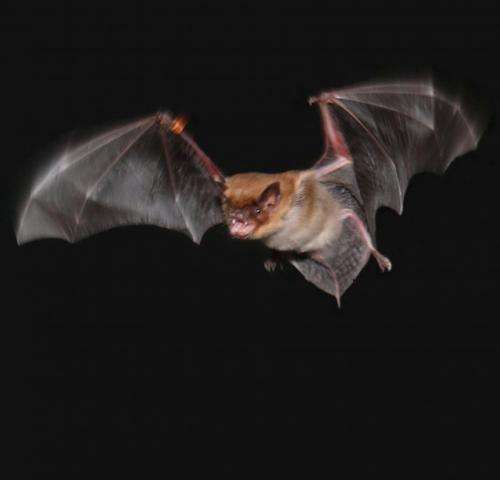Foraging bats can warn each other away from their dinners

Look into the spring sky at dusk and you may see flitting groups of bats, gobbling up insect meals in an intricately choreographed aerial dance. It's well known that echolocation calls keep the bats from hitting trees and each other. But now scientists have learned some bats emit another call: one that tells their comrades to "back off" from bugs they've claimed for themselves.
Led by Biology Research Associate Genevieve Spanjer Wright, a five-person team from the University of Maryland found that male big brown bats can produce a special sound, called a "frequency-modulated bout" (FMB), that tells other bats with whom they are foraging to keep away from their prey. The Maryland researchers are the first to report this ultrasonic social call produced exclusively by flying, foraging male big brown bats. Their study, appearing in the March 31 issue of the Cell Press journal Current Biology, shows how important vocal social communication is for a nocturnal animal foraging with others of its species.
As the researchers examined audio recordings from two bats flying and foraging together, they noticed calls that seemed different from typical echolocation. To find out more, they analyzed video and audio recordings of bats' flight paths and calls, while male and female big brown bats flew alone and in pairs foraging for tethered mealworms. This led them to discover the special call they dubbed FMB.
The FMB is an ultrasonic social call that uniquely identifies the bat emitting it. It is a sequence of three to four sounds, longer in duration and lower in frequency than the typical echolocation pulses that big brown bats use to navigate. It is often followed by short buzz-like calls.
The researchers found the FMB increases the caller's success in snagging the insect for himself. After hearing the FMB, other bats increased their distance from the caller and moved away from the prey.
"When two males flew together in a trial, it was not uncommon for each bat to emit FMBs," says Wright. "We found that the bat emitting the greatest number of FMBs was more likely to capture the mealworm."
While some animals that forage in groups are known to emit calls to attract others towards food sources, the FMB is used to repel, not attract, other bats.
"Despite decades of study, many things about common bat behaviors such as foraging remain mysterious," says Wright. "We were able to study a social call that is likely occurring thousands of times a night all over North America during the summer months, yet had not been described or studied before now."
The researchers discovered only male big brown bats emitted the FMB, possibly to advertise their dominance or claim their territory. Female bats did not emit FMBs. That may be because females form close associations with their roost mates and may forage near familiar individuals, while males often roost alone or in small bachelor colonies and may be less familiar with others foraging nearby.
More information: Current Biology article, "Social Calls Predict Foraging Success in Big Brown Bats" will be available on Thursday, March 27 on the journal's website.
Journal information: Current Biology
Provided by University of Maryland
















